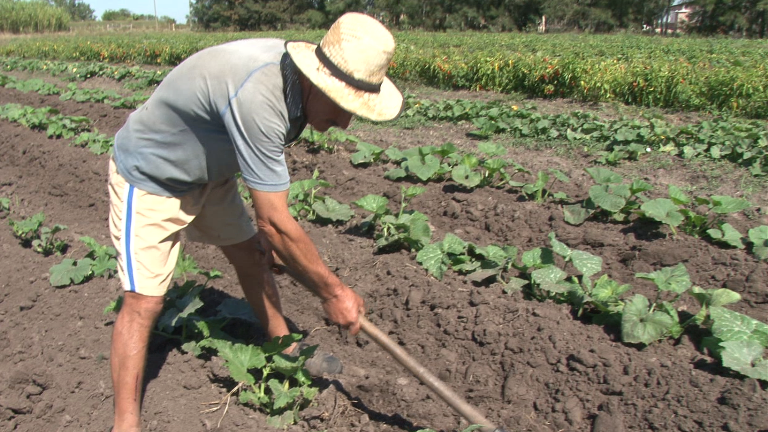It is siesta time on the outskirts of Canelones, 50 kilometers from the city of Montevideo. The intense sun and temperatures make working after midday impossible. That is why the fields in this area have transformed, at least for a few hours, into a wasteland without a person in sight. Neither are there many animals. The heat forces them to seek shelter.
For farmer Orlando Marenco, it is a well-deserved rest after a workday that began before dawn. Although there is nothing apparently unusual about the plot where he grows peppers, squash and sweet potatoes, he says it was necessary to introduce technological improvements to mitigate the impact of insufficient rains.
These improvements include a solarization system, which basically consists of covering entire parcels of certain crops with plastic sheeting to conserve heat and humidity. “The sun is very strong and if planting is not done with shade, the sun will burn everything,” Marenco says as he proffers one of his most prized products: sweet cherry tomatoes.
“The weather is difficult and there is nothing we can do except adapt to it,” he adds. Marenco’s story is just one of many about how Uruguayan farmland is being adapted to climate change: a problem that is no longer part of the future, but it is here and now.
Four degrees hotter in Uruguay
In recent years, the country has experienced a temperature increase and record numbers of floods and droughts. These phenomena have caused significant economic losses, especially in a country where the agricultural sector is one of the main economic drivers, accounting for 70% of Uruguayan exports.
To put it in perspective, Uruguay’s Ministry of Livestock, Agriculture and Fishing (MGAP) estimates that economic losses in the beef livestock industry during the 2008-2009 drought ranged from US$ 750 million to US$ 1 billion.
Thus, climate variability in a country with a heavy dependence on its natural resources has a particularly negative impact, especially on farm families such as that of Marenco, which represent 63% of the country’s total rural producers.
The future scenario is not encouraging. According to estimates of the World Bank’s Climate Change Knowledge Portal, in the year 2100, the country will face an average temperature increase of 3.4ºC, 57% more rainfall and greater frequency and intensity of the extreme weather phenomena that are already apparent: violent rain storms, winds and hailstorms, but also serious droughts.
An app for farmers
What should be done to address this situation? Recently, Uruguayans have implemented several efforts with a clear objective: adapt to the new climate.
In addition to the concrete actions that Uruguay is implementing to reduce greenhouse gas emissions and to apply technology to improve agricultural production, one of the country’s most interesting advances is the development of the National Agricultural Information System (SNIA). This is an ambitious web platform that the MGAP will implement with a view to consolidating, in a single portal, information that will serve to integrate and generate data such as forecasts and early climate warnings, and monitoring of vegetation, soil and water resources to enable the generation of programs to simulate the impact of the use of new technologies.
According to scientist Walter Baethgen, director of the Regional Program for Latin America and the Caribbean of Columbia University’s International Institute for Climate and Society, “the scientific community gives us predictions for 2080 or 2100 but for decision-makers – whether a ministry or a small-scale livestock producer – we need to know what will happen in the short term,” says.
“Uruguay is taking an exemplary step in adapting to climate change, not only to benefit its inhabitants, but also those of other countries around the world that may be interested in a tool like this one,” explains Holger Kray, lead agricultural economist at the World Bank.
The platform, which has World Bank financial support, will also help predict, control and plan different climate scenarios. It is expected to be launched mid-year.


